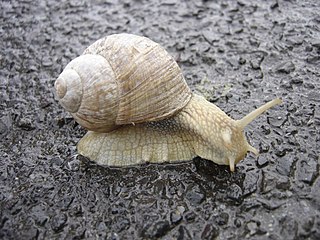
A snail is a shelled gastropod. The name is most often applied to land snails, terrestrial pulmonate gastropod molluscs. However, the common name snail is also used for most of the members of the molluscan class Gastropoda that have a coiled shell that is large enough for the animal to retract completely into. When the word "snail" is used in this most general sense, it includes not just land snails but also numerous species of sea snails and freshwater snails. Gastropods that naturally lack a shell, or have only an internal shell, are mostly called slugs, and land snails that have only a very small shell are often called semi-slugs.
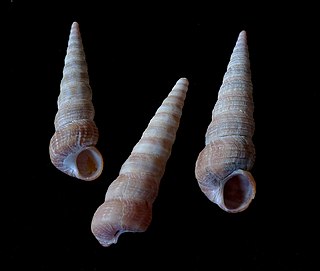
A spire is a part of the coiled shell of molluscs. The spire consists of all of the whorls except for the body whorl. Each spire whorl represents a rotation of 360°. A spire is part of the shell of a snail, a gastropod mollusc, a gastropod shell, and also the whorls of the shell in ammonites, which are fossil shelled cephalopods.

Cornu aspersum, known by the common name garden snail, is a species of land snail in the family Helicidae, which includes some of the most familiar land snails. Of all terrestrial molluscs, this species may well be the most widely known. It was classified under the name Helix aspersa for over two centuries, but the prevailing classification now places it in the genus Cornu.

Conus marmoreus, common name the "marbled cone", is a species of predatory sea snail, a marine gastropod mollusk in the family Conidae, the cone snails, cone shells or cones. It is the type species for the genus Conus. This is a species which is believed to feed mostly on marine molluscs including other cone snails. This snail is venomous, like all cone snails.

Zonitoides nitidus is a species of small, air-breathing land snail, a terrestrial pulmonate gastropod mollusc in the family Gastrodontidae.

A land snail is any of the numerous species of snail that live on land, as opposed to the sea snails and freshwater snails. Land snail is the common name for terrestrial gastropod mollusks that have shells. However, it is not always easy to say which species are terrestrial, because some are more or less amphibious between land and fresh water, and others are relatively amphibious between land and salt water.

Theba pisana, common names the white garden snail, sand hill snail, white Italian snail, Mediterranean coastal snail, and simply just the Mediterranean snail, is an edible species of medium-sized, air-breathing land snail, a terrestrial pulmonate gastropod mollusk in the family Helicidae, the typical snails.

Ellobiidae, common name the hollow-shelled snails, is a family of small air-breathing land snails, terrestrial pulmonate gastropod mollusks in the clade Eupulmonata. Ellobiidae is the only family in the superfamily Ellobioidea, according to the taxonomy of the Gastropoda by Bouchet & Rocroi, 2005).
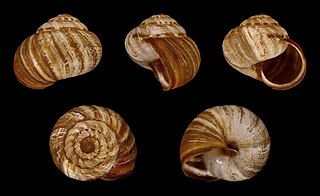
Xeromunda is a genus of small air-breathing land snails, terrestrial pulmonate gastropod mollusks in the subfamily Helicellinae of the family Geomitridae, the harry snails and their allies.
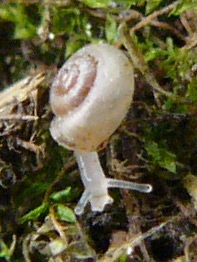
Vallonia pulchella, common name the lovely vallonia, is a species of very small air-breathing land snail, a terrestrial pulmonate gastropod mollusk in the family Valloniidae.
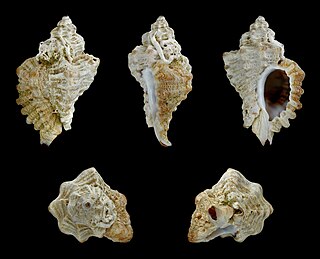
Ocenebra erinaceus, common name the European sting winkle, is a species of predatory sea snail, a marine gastropod mollusk in the family Muricidae, the murex and rock snails. Also known as the Oyster Drill, it is a pest in Oyster beds.

Rumina is a genus of medium-sized predatory land snails, terrestrial pulmonate gastropod mollusks in the family Achatinidae.

Conus ventricosus mediterraneus is a subspecies of sea snail, a marine gastropod mollusk in the family Conidae, the cone snails and their allies.

Columbella rustica is a species of sea snail, a marine gastropod mollusk in the family Columbellidae, the dove snails.
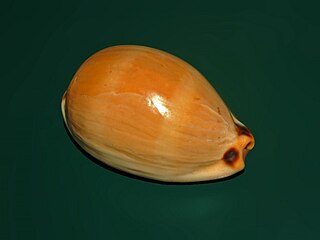
Luria lurida is a species of sea snail, a cowry, a marine gastropod mollusk in the family Cypraeidae, the cowries.

Thylacodes arenarius is a species of sea snail, a marine gastropod mollusk in the family Vermetidae, the worm snails or worm shells.
Conus vayssierei is a species of sea snail, a marine gastropod mollusk in the family Conidae, the cone snails and their allies.
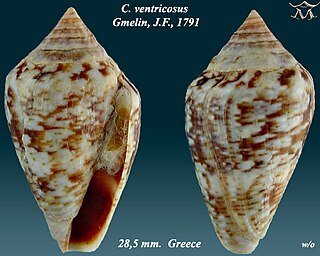
Conus ventricosus, common name the Mediterranean cone, is a species of sea snail, a marine gastropod mollusk in the family Conidae, the cone snails and their allies.

Tritia neritea is a species of sea snail, a marine gastropod mollusk in the family Nassariidae, the Nassa mud snails or dog whelks.






















